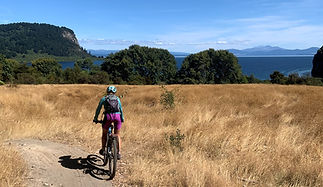
GETTING STARTED
TRAINING FOR THE REBEL RIDE
For those that spend a decent amount of time on the bike already you could probably get away with limited training i.e. a few big rides.
If you want a bit more guidance on how often to ride in the lead up to ensure you can conquer the ride (and still have a smile or two to spare) training programmes can be a worth-while investment. Most bike coaches can offer tailored programmes.
Here are a few top tips from me to you…
TOUGHEN YOUR BUTT
-
Even when your legs are tired, they can still keep spinning but a tender bum is not as forgiving. It can make you throw you bike down and cry at a beach for 20 minutes because it just hurts that much.
-
If you aren’t a regular rider, sit on a saddle as much as you can leading up the ride. Wear the chamois shorts, use the creams. It’s worth it so that your butt doesn’t fall off.
IF YOU’RE NOT THAT CONFIDENT ON MOUNTAIN BIKE TRACK
-
If narrow trails, mud, switch backs, obstacles like roots or rocks make you nervous, seek out some mountain biking workshops.
-
Ask your local mountain bike club to point you in the right direction for some beginners sessions or connect with a bike coach.
-
We recommend getting familiar with mountain bike trails before the Rebel Ride.
IF YOU’RE WORRIED ABOUT THE OPEN ROAD…
-
Ask some friends that are road bikers to take you out on country roads. You can usually find a local no-drop bunch ride but they will likely expect you to be riding a road bike, clipped in with cleats.
-
Don’t be scared to go for a ride on open roads by yourself. This ride doesn’t go on highways so choose quieter country roads to train on It doesn’t take too long to get used to it.
-
Here are a few tips from Cycle Coach Janet Stark about sharing the road.
-
Also see: Cycling Safely: Top Tips for Being Seen on the Road - YouTube
RIDING WITH A LOADED BIKE….
Putting extra weight on your bike does affect the handling, especially where you load the weight, but it doesn’t take that long to adapt to it.
You don’t need to ride all the time with fully kitted out bike in the lead up but do take your bike for a few spins with the gear on it just to make sure it doesn’t fall off.




GEAR
I’ll provide a recommended gear list to those that register but the main things to cover…
THE BIKE
Almost any bike in good working order will do the trick. You don’t need suspension but don't use a road bike as you run the risk of damaging the bike on the offroad sections and the skinny tyres/wheels will struggle for traction. Other rigid bikes such as steel bikes or gravel bikes will be fine. If you’re spoilt for choice, a hardtail MTB would be a safe bet for this ride.
Whatever bike you choose, please ensure it has appropriate tyres for mountain bike trails / offroad riding - ask your local bike shop to fit you for these.
THE BAGS
Bike bags are recommended but can be a pricey investment so consider the following hacks. Panniers would be fine.
-
Ask around - do you know anyone that has bags you could borrow?
-
Strap a dry bag to your handlebar: Bikepacking Hacks: DIY & Budget Handlebar Bags - YouTube
-
Use a backpack
-
Use a hydration pack
-
Buy second hand
Beware short riders: seat post/saddle bags won’t always clear your rear tyre. I’m 160cm and I have to use a pannier rack. Frame bags often won’t fit your bike either (blame the patriarchy, it’s probably responsible). You can get cool custom frame bags made by local designers if you have the time and money to do so.
SLEEPING OUT
To camp or not to camp, that is the question. What it adds in gear and weight it almost certainly adds in adventure too. Bivvies or light weight solo tents are perfect for bike packing and usually can fit in your front roll (the bag attached to your handle-bar). Squeeze in your sleeping bag and a camping mat and you are good to go. If you already have lightweight gear or know someone who will let you borrow – go for it!
Note: It’s not a requirement for this ride to carry overnight sleepout gear. As long as you’ve booked the accommodation, confirmed it and are prepared to make that distance you can just ride with your clothes, food and bike stuff. You will need to take some emergency supplies and kit in case of … well an emergency.
EXTRA INFORMATION AND INSPIRATION
Janet Starks Bikepacking 101 e-book ($5NZD). A guide for the first time Bikepacker, with information on gear, bikes and suggested bike routes. Getting you ride ready for your adventure.
Ground Effect have a tonne of useful resources for first-time bike packers on their website. Check out some of their blogs:
Bikepacking 101 - BIKEPACKING.com: This site can sometimes be a bit overwhelming/hardcore for newbies but it’s still filled with loads of handy information. I love this article series - Rad Women of Bikepacking - BIKEPACKING.com
RAD Bike adventure VLOG | YouTube: Informational bike touring and bikepacking content that's fun and accessible. They also travelled by bike around NZ in 2019 – check it out.
North Shore Betty - YouTube: If you think you’re too old. You’re not.
All Bodies on Bikes | SHIMANO - YouTube – If you think you’re too big. You’re not.
Life of Pie - YouTube: Pizza and Bikes can fix anything.
Why She Adventures NZ Podcast – She Adventures NZ
Bike Community with Cycle Coach - Janet Stark | Facebook Group

